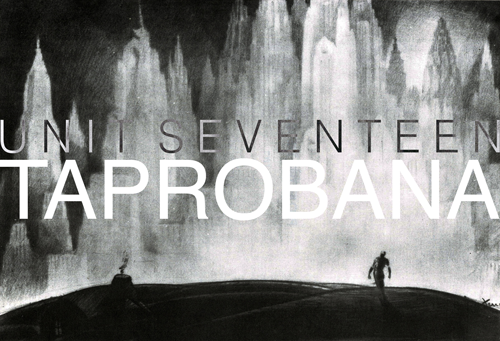
Arthur C Clarke’s 1979 novel, The Fountains of Paradise, describes the construction of a colossal orbital
tower situated at the summit of a remote, sacred mountain on the semifictional, equatorial island of
Taprobane [1] . The tower, a sort of ‘space elevator’ is capable of transporting payloads of both passengers
and cargo to and from its geostationary anchor at 36,000km above sea level, using a relatively small
amount of energy. Providing a platform for both rocketless access to space and asteroid mineral
harvesting, the tether is presented a viable solution to a prediction of a crisis in world resources.
The tectonics of Clarke’s vision, will not be the focus of the unit’s interests but will however, be present;
facilitating projects dedicated to the rapid urbanisation that might result from it. In this sense the tower will
play t he role of what Robin Evans might describe as an agent of ‘ synthetic interference[2]’; limiting some of
the current available activities but offering a range of new ones entirely different in character. We will be
exploring the implications of intertwining a radical new infrastructure within a remote landscape rich in
mythical heritage and cultural significance and enjoying t he curious hybridities and ‘ free spaces[3]’ t hat are
likely to result.
‘A deeper level of construction fuses the new and the old, reconciling, coalescing them, without compromising either one in the name of contextual or other form of unity. The scar is a mark of pride, both for what has been lost and what has been gained. It cannot be erased, except by the most cosmetic means. It cannot be elevated beyond what it is, a mutant tissue, the precursor of unpredictable regenerations.’ Lebbeus Woods, War and Architecture, 1993
The site for the year will be the area surrounding Sigiriya, near Dambulla in the Matale District (central
province) of Sri Lanka. Incoming students will elect to work in groups or individually to design urban
proposals for a new city centered at least economically on Clarke’s elevator. Historical evaluation of the
impact of colonial infrastructure to the islands industries along with equivalent rapid urbanisation events
such as the goldrush expansion of San Francisco will serve to structure the decision making. Students
will develop and evaluate urban proposals against key examples of visionary cities and individual building
projects will emerge through the identification of critical typologies. A field trip to Sri Lanka taking place in
January will provide an opportunity to gather research and carry out surveys using a range of digital
techniques.
Through the course of discussions U17 will be continuing its focus on digital semiotics. We are interested
in digital working methods and their capacity for processing and communicating the ‘unseen’ in architecture. Students will engage in digital design and making techniques to develop means of representation relevant to the discourse.
Y2 Students will develop the themes set out in Y1 to establish suitable individual briefs for their thesis
projects. Throughout the year the unit will be supported by architects/ designers at Wilkinson Eyre and
Piercy & Company and engineers from Robert Bird and Price & Myers. Students will be encouraged to
take advantage of the advanced fabrication facilities at Grymsdyke Farm and intensive working trips will
be available to U17 students over the course of the year.
__
1 The name of an island depicted in Ptolemy’s map 0f 1535. It is unclear whether the map describes Sri Lank a or Sumatra
2 Para Robin Evans Towards Anarchitecture, AA 1997
3 Para Lebbeus Woods, War and Architecture, Pamphlet Architecture 15, 1993